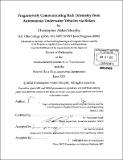| dc.contributor.advisor | Hanumant Singh. | en_US |
| dc.contributor.author | Murphy, Christopher Alden | en_US |
| dc.contributor.other | Woods Hole Oceanographic Institution. | en_US |
| dc.date.accessioned | 2012-12-13T18:48:38Z | |
| dc.date.available | 2012-12-13T18:48:38Z | |
| dc.date.copyright | 2012 | en_US |
| dc.date.issued | 2012 | en_US |
| dc.identifier.uri | http://hdl.handle.net/1721.1/75643 | |
| dc.description | Thesis (Ph. D.)--Joint Program in Applied Ocean Science and Engineering (Massachusetts Institute of Technology, Dept. of Electrical Engineering and Computer Science; and the Woods Hole Oceanographic Institution), 2012. | en_US |
| dc.description | Cataloged from PDF version of thesis. | en_US |
| dc.description | Includes bibliographical references (p. 118-131). | en_US |
| dc.description.abstract | As analysis of imagery and environmental data plays a greater role in mission construction and execution, there is an increasing need for autonomous marine vehicles to transmit this data to the surface. Without access to the data acquired by a vehicle, surface operators cannot fully understand the state of the mission. Communicating imagery and high-resolution sensor readings to surface observers remains a significant challenge - as a result, current telemetry from free-roaming autonomous marine vehicles remains limited to 'heartbeat' status messages, with minimal scientific data available until after recovery. Increasing the challenge, long-distance communication may require relaying data across multiple acoustic hops between vehicles, yet fixed infrastructure is not always appropriate or possible. In this thesis I present an analysis of the unique considerations facing telemetry systems for free-roaming Autonomous Underwater Vehicles (AUVs) used in exploration. These considerations include high-cost vehicle nodes with persistent storage and significant computation capabilities, combined with human surface operators monitoring each node. I then propose mechanisms for interactive, progressive communication of data across multiple acoustic hops. These mechanisms include wavelet-based embedded coding methods, and a novel image compression scheme based on texture classification and synthesis. The specific characteristics of underwater communication channels, including high latency, intermittent communication, the lack of instantaneous end-to-end connectivity, and a broadcast medium, inform these proposals. Human feedback is incorporated by allowing operators to identify segments of data that warrant higher quality refinement, ensuring efficient use of limited throughput. I then analyze the performance of these mechanisms relative to current practices. Finally, I present CAPTURE, a telemetry architecture that builds on this analysis. CAPTURE draws on advances in compression and delay tolerant networking to enable progressive transmission of scientific data, including imagery, across multiple acoustic hops. In concert with a physical layer, CAPTURE provides an end-to- end networking solution for communicating science data from autonomous marine vehicles. Automatically selected imagery, sonar, and time-series sensor data are progressively transmitted across multiple hops to surface operators. Human operators can request arbitrarily high-quality refinement of any resource, up to an error-free reconstruction. The components of this system are then demonstrated through three field trials in diverse environments on SeaBED, OceanServer and Bluefin AUVs, each in different software architectures. | en_US |
| dc.description.statementofresponsibility | by Christopher Alden Murphy. | en_US |
| dc.format.extent | 131p. | en_US |
| dc.language.iso | eng | en_US |
| dc.publisher | Massachusetts Institute of Technology | en_US |
| dc.rights | M.I.T. theses are protected by
copyright. They may be viewed from this source for any purpose, but
reproduction or distribution in any format is prohibited without written
permission. See provided URL for inquiries about permission. | en_US |
| dc.rights.uri | http://dspace.mit.edu/handle/1721.1/7582 | en_US |
| dc.subject | Joint Program in Applied Ocean Science and Engineering. | en_US |
| dc.subject | Electrical Engineering and Computer Science. | en_US |
| dc.subject | Woods Hole Oceanographic Institution. | en_US |
| dc.subject.lcsh | Underwater acoustic telemetry | en_US |
| dc.subject.lcsh | Vehicles, Remotely piloted | en_US |
| dc.title | Progressively communicating rich telemetry from autonomous underwater vehicles via relays | en_US |
| dc.title.alternative | Progressively communicating rich telemetry from AUVs via relays | en_US |
| dc.type | Thesis | en_US |
| dc.description.degree | Ph.D. | en_US |
| dc.contributor.department | Joint Program in Applied Ocean Physics and Engineering | en_US |
| dc.contributor.department | Woods Hole Oceanographic Institution | en_US |
| dc.contributor.department | Massachusetts Institute of Technology. Department of Electrical Engineering and Computer Science | |
| dc.identifier.oclc | 818256877 | en_US |
